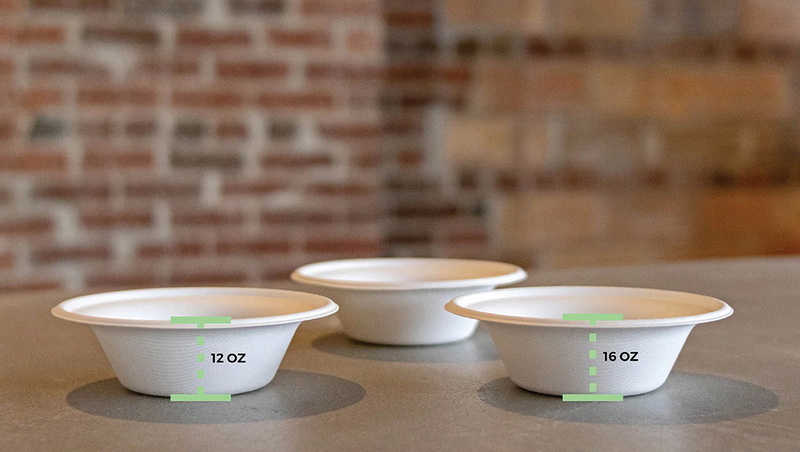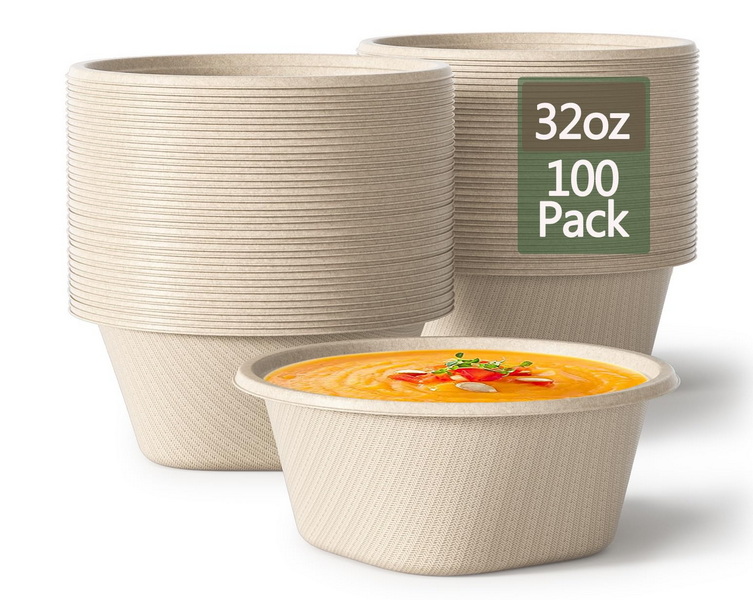
Content Menu
● The Environmental Cost of Traditional Disposable Bowls
● What are Ecofriendly Biobased Disposable Soup Bowls?
● Advantages of Ecofriendly Biobased Disposable Soup Bowls
● Comparison with Other Types of Disposable Bowls
● Applications of Ecofriendly Biobased Disposable Soup Bowls
● How to Choose the Right Ecofriendly Biobased Disposable Soup Bowl
● Proper Disposal of Ecofriendly Biobased Disposable Soup Bowls
● Conclusion
● FAQ
>> 1. Are ecofriendly biobased disposable soup bowls really better for the environment?
>> 2. What are ecofriendly biobased disposable soup bowls made of?
>> 3. Are ecofriendly biobased disposable soup bowls safe for hot soup?
>> 4. Where can I buy ecofriendly biobased disposable soup bowls?
>> 5. How do I dispose of ecofriendly biobased disposable soup bowls?
● Citations:
In today's fast-paced world, convenience often trumps environmental concerns. However, with growing awareness about the detrimental effects of traditional plastics, more people and businesses are seeking sustainable alternatives. Ecofriendly biobased disposable soup bowls have emerged as a promising solution, offering a blend of convenience and environmental responsibility. This article explores the numerous advantages of using these innovative bowls, highlighting their positive impact on the planet and human health.

The Environmental Cost of Traditional Disposable Bowls
Traditional disposable bowls, typically made from plastic or styrofoam, pose significant environmental challenges[9][10]. These materials are derived from fossil fuels, a non-renewable resource, and their production contributes to greenhouse gas emissions[9]. Furthermore, plastic and styrofoam are not biodegradable, meaning they can persist in the environment for hundreds or even thousands of years[1]. This leads to:
- Landfill Overflow: Accumulation of non-biodegradable waste in landfills, taking up valuable space and potentially contaminating soil and water[2].
- Ocean Pollution: Plastic debris entering oceans, harming marine life through entanglement, ingestion, and habitat destruction[1].
- Microplastic Contamination: Breakdown of plastics into microplastics, which can enter the food chain and pose risks to human health[10].
What are Ecofriendly Biobased Disposable Soup Bowls?
Ecofriendly biobased disposable soup bowls are designed to mitigate these environmental problems. They are made from renewable resources such as:
- Cornstarch: Cornstarch bowls are environmentally friendly, safe for food, and resistant to spills and leaks[1]. They can also be used in microwaves and freezers[1].
- Sugarcane Bagasse: Bagasse is the fibrous residue left after sugarcane is processed. It's a compostable material, requiring less energy to produce than wood pulp[3][6].
- Bamboo: Bamboo is a fast-growing, renewable resource that requires minimal pesticides or fertilizers[10].
- Recycled Paper: Using recycled paper reduces the demand for virgin wood pulp and minimizes deforestation[3].
These materials are biodegradable and often compostable, meaning they break down naturally in the environment, reducing waste and pollution[2][5].
Advantages of Ecofriendly Biobased Disposable Soup Bowls
Switching to ecofriendly biobased disposable soup bowls offers a wide array of benefits:
1. Environmental Sustainability: These bowls significantly reduce environmental impact compared to traditional plastic or styrofoam options[1][9]. They are biodegradable and compostable, minimizing landfill waste and pollution[2].
2. Reduced Carbon Footprint: The production of biobased materials often requires less energy than plastic production, leading to a smaller carbon footprint[1][4].
3. Renewable Resources: Ecofriendly bowls are made from renewable resources, ensuring the sustainability of the materials used[10].
4. Non-Toxic: Biobased materials are generally non-toxic and safe for contact with food, unlike some plastics that can leach harmful chemicals when heated[2].
5. Compostable: Many ecofriendly bowls are compostable, meaning they can be broken down into nutrient-rich soil[2].
6. Versatile: Biodegradable bowls are suitable for many uses, including disposable bowls, serving platters for snacks, fruit, and salads[2]. They come in a variety of sizes and shapes, making them perfect for a variety of occasions, from picnics and BBQs to parties and catered events[2].
7. Enhanced Hygiene: Since they are single-use, there is no risk of cross-contamination that can occur with reusable bowls, which is especially important in settings like hospitals, schools, and catering services where maintaining high hygiene standards is crucial[8].
8. Time-Saving: Using disposable bowls saves time that would otherwise be spent washing and drying dishes[4][8]. This time can be better spent on other important aspects of the business, such as improving customer service or preparing more delicious meals[4][8].
9. Heat Resistance: Some eco-friendly bowls have enhanced heat resistance and insulation properties, making them suitable for hot and cold food items[1].

Comparison with Other Types of Disposable Bowls
| Feature | Ecofriendly Biobased Bowls | Plastic/Foam Bowls | Paper Bowls | Bamboo Bowls |
| Environmental Impact | Biodegradable, compostable, made from renewable resources | Non-biodegradable, contributes to pollution, made from fossil fuels | Recyclable but may not hold up well with liquids | Renewable, biodegradable, but can be more expensive |
| Durability | Sturdier and more heat-resistant than plastic or foam | Less sturdy, may melt or warp with hot foods | Less durable, may not hold up well with liquid or greasy foods | Durable and strong |
| Cost | Can be slightly more expensive than plastic/foam but becoming more competitive | Generally inexpensive | Relatively inexpensive | Can be more expensive |
| Food Safety | Non-toxic, safe for hot and cold foods | Can leach chemicals when heated, potentially harmful | Generally safe but may not be suitable for all types of food | Safe for all types of food |
| Versatility | Suitable for a variety of foods and occasions | Limited heat resistance, not suitable for all types of food | Best for dry and lightweight meals | Suitable for a variety of foods and occasions |
Applications of Ecofriendly Biobased Disposable Soup Bowls
Ecofriendly biobased disposable soup bowls are suitable for a wide range of applications:
- Restaurants and Cafes: Serving soups, stews, and other hot dishes in an environmentally responsible manner[3][6].
- Catering Services: Providing convenient and sustainable tableware for events and gatherings[4].
- Food Trucks: Offering eco-conscious options for on-the-go meals[3].
- Hospitals and Schools: Maintaining hygiene standards while reducing environmental impact[8].
- Home Use: Enjoying convenient and guilt-free meals at home[4].
How to Choose the Right Ecofriendly Biobased Disposable Soup Bowl
When selecting ecofriendly biobased disposable soup bowls, consider the following factors[1]:
- Material: Choose bowls made from certified biodegradable or compostable materials like cornstarch, sugarcane bagasse, or bamboo[10].
- Certification: Look for certifications from organizations like the Biodegradable Products Institute (BPI) or the Compost Manufacturing Alliance (CMA) to ensure the product meets environmental standards[10].
- Size and Capacity: Select the appropriate size and capacity for your specific needs[1].
- Heat Resistance: Ensure the bowls are suitable for serving hot soups and other hot dishes[10].
- Durability: Check for sturdiness and resistance to leaks and spills[1].
- Cost-Effectiveness: Compare prices from different suppliers to find the best value[1].
Proper Disposal of Ecofriendly Biobased Disposable Soup Bowls
To maximize the environmental benefits of ecofriendly biobased disposable soup bowls, it is essential to dispose of them properly[1][9]:
- Composting: If the bowls are certified compostable, dispose of them in a commercial or home composting system[2].
- Recycling: Some biobased materials, like recycled paper, can be recycled[9]. Check with your local recycling program for guidelines.
- Landfill: As a last resort, dispose of the bowls in a landfill. While this is not the ideal option, they will still break down faster than traditional plastics[1].
Conclusion
Ecofriendly biobased disposable soup bowls offer a sustainable and responsible alternative to traditional disposable tableware. By choosing these innovative bowls, individuals and businesses can reduce their environmental impact, conserve resources, and promote a healthier planet. As awareness grows and technology advances, ecofriendly biobased disposable soup bowls are poised to become the standard for convenient and environmentally conscious dining.

FAQ
1. Are ecofriendly biobased disposable soup bowls really better for the environment?
Yes, ecofriendly biobased disposable soup bowls are significantly better for the environment than traditional plastic or styrofoam bowls. They are made from renewable resources, biodegradable, and often compostable, reducing waste and pollution[1][2][9].
2. What are ecofriendly biobased disposable soup bowls made of?
Ecofriendly biobased disposable soup bowls are commonly made from materials like cornstarch, sugarcane bagasse, bamboo, and recycled paper[3][10].
3. Are ecofriendly biobased disposable soup bowls safe for hot soup?
Yes, many ecofriendly biobased disposable soup bowls are designed to be heat-resistant and suitable for serving hot soups and other hot dishes[1][10].
4. Where can I buy ecofriendly biobased disposable soup bowls?
Ecofriendly biobased disposable soup bowls are available from various online retailers, restaurant supply stores, and eco-conscious retailers[4].
5. How do I dispose of ecofriendly biobased disposable soup bowls?
The best way to dispose of ecofriendly biobased disposable soup bowls is through composting. If composting is not an option, they can be recycled or disposed of in a landfill[1][2].
Citations:
[1] https://www.hydepackage.com/info-detail/advantages-of-using-disposable-cornstarch-bowls
[2] https://www.eco-pack.com/news/benefits-of-using-biodegradable-bowls-77168994.html
[3] https://www.yoonpak.com/best-disposable-bowls-for-hot-soup/
[4] https://www.hydepackage.com/info-detail/enjoy-disposable-bowls-that-save-time-and-trouble
[5] https://www.agreenproducts.ca/benefits-of-using-compostable-deli-bowls-and-lids/
[6] https://www.biogreenchoice.com/collections/bowls
[7] https://www.craftecopack.com/blog/6-best-disposable-bowls-for-hot-soup-everything-you-need-to-know_b26
[8] https://www.sweetflavorfl.com/blog/everything-you-need-to-know-about-disposable-salad-bowls-n14
[9] https://www.luzhou-pack.com/sustainable-elegance-exploring-the-world-of-eco-friendly-disposable-bowls.html
[10] https://purpleclay.com/blogs/news/eco-friendly-disposable-bowls-a-step-towards-sustainable-living

















